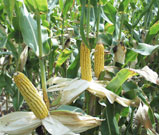 |
Getting a Late Start
By Justin Petrosino, ANR Extension Educator
OSU Extension, Darke County
With the final rain gauge emptying in April the rainfall total was a
few hundredths over eight inches. May is not looking much better with
just under an inch and a quarter so far. So what does all this mean for
our crops this year?
Let’s dive into wheat. It’s been a season of extremes for wheat, a warm
dry fall and a cool wet spring. Most of our fields have been top
dressed with spring nitrogen; however, there are a few still looking a
little yellow. Most of our wheat is between Feekes 6 (jointing) and 7.
Although the optimum timing for N application to wheat is Feekes 6 we
can still stretch applications into Feekes 8 and 9 with only taking a
10-15% yield loss. Late N applications should be made as soon as
possible, with UAN applications being banded to avoid leaf burn.
Another concern with cool, wet weather in wheat is diseases. Powdery
mildew and Septoria tritici can be a concern but we are still a few
weeks away from making a decision on fungicide application. If diseases
are found in the field now, use their location as a guide for scouting
around flag leaf emergence.
Corn is a hot topic of discussion. A lot of questions revolve around
switching to a short season hybrid or even if corn will be a viable
option this year. Some recent work with planting date and maturity by
Dr. Peter Thomison, OSU Corn Specialist, and Dr. Bob Nielsen, Purdue
Corn Specialist showed that late planted (June 11) corn matured 9 days
after planting sooner than corn planted on time (May 2). So how does
earlier maturation and fewer growing degree days transition into yield?
Well, the good old Ohio Agronomy Guide says that a hybrid planted at an
optimal seeding rate as late as May 19 will still yield 91% of its
optimum yield. A recent study by Sindelar et al., published in 2010,
showed that late planted corn suffered a 10% yield loss in a low stress
year, and if late planted corn suffered season long drought stress a 60
% yield loss occurred. So what do we take from this? Planting date is
only one of many factors that contribute to yield. Most resources say
that planting date and rate together make up about 10-15 % of yield. We
can still plant corn at an optimum rate at a later date and still
expect a decent yielding crop.
So how do we preserve yields in late planted corn? Obviously proper
fertility and weed control will play a large role in yield. For
information on both of these factors, visit the two most recent issues
of the CORN Newsletter (issues 2011-6 and 2011-7) at
http://corn.osu.edu. Dr.’s Thomison, Mullen, and Loux (Corn specialist,
Fertility specialist, and Weed specialist) have great articles on how
to manage late planted corn.
It might also be prudent to read up on a few insect pests this year.
Dr. Ron Hammond and Dr. Andy Michel have some great resources available
on two pests to be on the lookout for. Black cutworm flights in
surrounding states have been fairly high this year. The adult moths fly
in this time of year and find weedy and cover cropped fields very
attractive for laying eggs. If you missed fall herbicide applications
and your fields are a pretty purple, yellow, or green right now, you
have an optimum black cutworm habitat. The next pest to be on the
lookout for is not really an insect but a gastropod. Corn emergence
this year will be timed with the growth stage where slugs do most of
their feeding. If you have fields or areas of a field with large
amounts of residue and have seen feeding before, you will want to keep
an eye out for slugs. For more information on these pests and others,
visit the site maintained by our entomologists at
http://entomology.osu.edu/ag/ . You can view factsheets and even videos
on how to manage these pests.
We aren’t close to throwing in the towel on corn this year. Visit the
Agronomic Crops website at http://agcrops.osu.edu/ to find all of the
relevant crop production bulletins, the latest issue of CORN, and
websites maintained by our state specialists. A little extra self study
on these cool rainy days will pay extra this year. It doesn’t hurt to
have a backup plan in place, but it is still a little too soon to
completely change your plans for this year.
|

